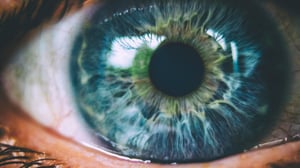Its name is opsin and it’s light-sensitive. When put into the eye of a patient with retinitis pigmentosa, it enabled recovery of the sight of the shape of some articles.
Optogenetics, the technique of using the very particular ability of some proteins obtained from seaweed or bacteria to be activated following light stimulation, could be a new frontier for the treatment of some forms of blindness.
After about 20 years of tests, first in the laboratory and then in animals, the first experiments on humans have started to give encouraging signs, reported in the scientific journal Nature Medicine.
In this specific case, the disease causing the loss of sight was retinitis pigmentosa, a rare genetic disease affecting the cells of the retina (the very fine nerve layer inside the eye) until it makes them unable to receive and process images. However, it doesn’t damage either the optic nerve or the ganglia, the groups of nerve cells acting as a filter when the retina is activated and then sends the images to the brain for processing.
In patients, the loss of retina function is progressive and irreversible. On average, the disease leads to blindness at a young age. However, as the disease doesn’t compromise brain structures, the ophthalmologists at the University of Pittsburgh, with colleagues from the University of Basle, decided to start experimenting their technique on this type of patient.
They chose eight of them and injected various dosages of an adenovirus, modified in the laboratory so that it would induce the production of opsin, a protein obtained from seaweed and able to react to light stimulation, directly into an eye, to replace the cells of the atrophied retina.
‘Tech’ glasses are also necessary
Some months after the injections, researchers found that opsin was also produced by a part of the neurons of ganglia.
At this point, the researchers gave the eight patients a series of special glasses, designed ad hoc, to amplify and focus the light rays collected by the opsin.
Only one of the eight patients has, for the time being, continued with the experimentation as the pandemic has slowed training with the glasses for the others.
The patient concerned is a 58-year-old Frenchman, blind since he was 40, who was given opsin in the more damaged eye. Before the test, he could only see some light and shade but wasn’t able to distinguish any shapes.
After treatment, he was able to distinguish dark outlines on a light background and vice versa (e.g. a pedestrian on a zebra crossing), identify three glasses on a table and other contrasting shapes; he was even able to open the house door, seeing the outline of the person who had knocked. At present, he has not regained the ability to distinguish colours.
These are apparently small steps, but they can make an enormous difference to the quality of life of people with severe blindness. In addition, some of the other seven patients, given higher doses of opsin, may succeed in seeing better defined images (as soon as they restart ‘training’ with the glasses), just as this may happen when everyone receives the second injection in the other eye.
Progress compared to the artificial retina
It should also be remembered that, to date, the preferred approach in these cases was the artificial retina, i.e. mini tele-cameras mounted on glasses and connected to micro-electrodes in the eye, under test for a number of years.
These have brought some progress, enabling patients to make out some shapes but they are extremely invasive, not easy to implant (with a surgical operation), calibrate and manage, and they have still not reached an optimal level of development. It’s clear that if a simple injection could ensure similar results, the whole sector would be given an extraordinary impulse and bring fresh hope to the blind.
Here’s the video of the experiment. Credit: Sahel, et al.; Nature Medicine.

